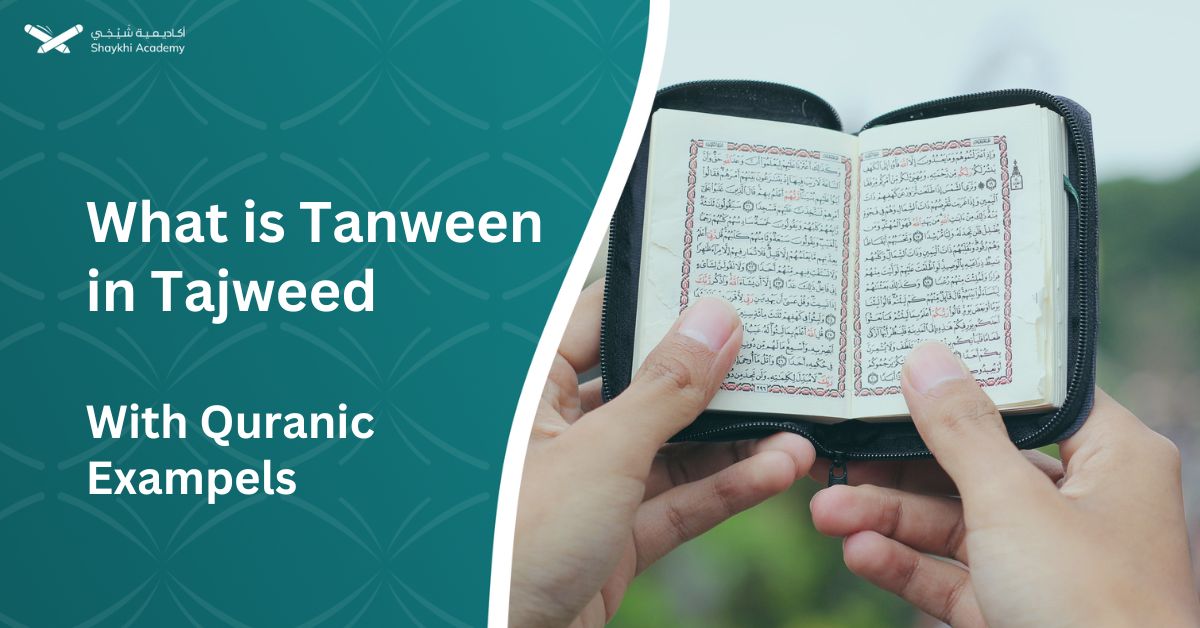Tanween, an additional “noon” sound added to the end of nouns or adjectives for grammatical clarity, aids in pronunciation and grammatical accuracy. It’s denoted by marks in writing and is crucial for understanding sentence structure and word function.
In Tajweed, Tanween rules are vital for precise Quranic recitation, ensuring proper understanding of verses. Categorized into Tanween in Fateh, Kasrah, and Dhamma, each type is represented by specific marks and pronunciation rules.
These rules, alongside those for Noon Sakinah, emphasize accurate pronunciation and adherence to Tajweed principles. They cover aspects like showing, assimilation, inversion, and hiding of Tanween, ensuring proper recitation of the Quran.
What is the definition of tanween in Arabic?
Tanween in the Arabic language is an additional “noon” sound that attaches to the end of a noun or adjective. It is not an original part of the word but is added for grammatical purposes, occurring only at the end of these words. Tanween appears in pronunciation but not as an independent letter in writing, making it unique to the ends of nouns and adjectives.
In written form, tanween is represented by specific marks placed above or below the final letter of the word, indicating the added sound. These marks are pronounced as an extra “noon” but are not written out as a full letter. This doubling of the final sound is essential for proper pronunciation and grammatical accuracy in Arabic.
To understand tanween better, one can think of it as similar to adding an “ing” sound to the end of an English verb, although this comparison is only about the pronunciation aspect and not the grammatical function. The marks for tanween (ً – ٍ – ٌ) serve as visual cues for the phonetic addition of the “noon” sound, which must be vocalized to convey the intended meaning accurately.
What is Tanween in the Quran?
Tanween in the Quran is one of the most important things that enable us to read the Quran correctly. By knowing its rules, you will be able to read the Holy Quran accurately and understand its meanings.
Tanween is one of the Arabic vowels that helps us read words without errors. It is always used at the end of words, and its pronunciation can be shortened in that when you find it at the end of a word, you will add the “n” sound to it.
The provisions on the pronunciation of tanween in the Holy Quran are determined by the rules of Tajweed.
What is Tanween in Tajweed?
Tanween is considered one of the most important rules in Tajweed, as it is an essential component of Arabic grammar and pronunciation which plays a pivotal role in the formation and interpretation of Arabic words and thus the interpretation of verses of the Holy Quran.
Tanween in Tajweed is an Arabic word for double vocalization that occurs at the conclusion of syllables and has the same sound as noon sakin.
What are The Types of Tanween?
There are 3 types of tanween which are:
1- Tanween in Fateh:
In Fateh, the sound is (tann), and It is denoted by a double fatha above the letter.
For example: I bought a new book (اشتريت كتابًا جديدًا)
2- Tanween in kasrah:
In Kasrah, the sound is (tinn), It is denoted by a double kasra under the letter.
For example: I wrote with a new pen (كَتَبْتُ بَـقَلَمٍ جَدِيْدٍ)
3- Tanween in dhamma:
In Dhamma, the sound is (tunn), It is denoted by a double dhamma above the letter.
For example: The boy is small (الولد صغيرٌ)
Tanween with Noon Sakin
Tanween is the combination of a double short vowel in the Arabic language along with pronouncing the sound of the Arabic letter An-Noon. However, Tanween cannot be replaced with the letter “An-noon” itself, especially when it comes as Noon saakinah.
Additional Alif with Tanween
When using Tanween with Al-fateh, an additional Alif without Hamza is written to place the Tanween mark on it. However, there are two exceptions where the additional Alif is not required, and the Tanween mark can be placed directly:
- When the final letter of an Arabic word is (ة) or (ـــة): This is called At-ta’a Al-marboota, for example, (معلمة) or (هرة).
- When the final letter of an Arabic word is Hamza (ء) preceded by the Arabic letter Alif Al-madd:
- ماءً
- سماءً
- هواءً
Note on Historical Linguistic Practices
Since the verbal method of uttering the Arabic language was different from the written method in the past, linguistic scholars innovated dots, signs, Tanween, etc., to make the written form of the Arabic language align with the correct verbal form.
To know more about improving your Arabic listening skills, don’t hesitate to reach out to us. You can also register for a free trial with the tutors of your choice at a time that suits you.
What are Tanween Rules in Tajweed?
The rulings on tanween in Tajweed always come in conjunction with the rulings on the noon Sakinah. So, what is noon Sakinah?
Noun Sakinah: It is a silent Noun that is confirmed verbally and in writing, as a link, and as a stop. It is used in nouns, verbs, and letters. It differs from Tanween in that Tanween is an additional silent Noun that only attaches to the last of the nouns verbally, and separates it in writing for other than emphasis.
Noon and the provisions of the static Tanween
The rulings on Noon Sakinah and Tanween are divided into four sections, as follows:
1- Showing (AL Izhar):
It means making the vowel sound or tanween pronounced when pronouncing one of the throat letters, and the throat letters are: (hamza, haa, ain, ha, ghayn, and khaa) and it occurs with the noon in one word, and an example of this is the Almighty’s saying in Surat Al-Fatihah: (You have been blessed أَنْعَمْتَ), and the manifestation is When the noon is in two words, like the Almighty’s saying: (From guide مِن هادٍ), the manifestation of the noon is only in two words, like the Almighty’s saying: (A great punishmentعَذَابٌ عَظِيمٌ ).
2- Assimilation (Idgham)
It means inserting a consonant into a vowel so that they become one stressed letter, and the assimilation letters are six, namely: ya, ra, mem, lam, waw, and nun) and assimilation is divided into two parts:
The first: assimilation with a song (Idgham with ghana)
The letters of this type are four, namely: Ya, Nun, Meem, and Waw. The condition is that the noon as a Sakinah or tanween is at the end of the first word, and the letter of assimilation is with ghanna at the beginning of the second word, as God Almighty says in Surat Al-Zalzalah: (And who makes a weight وَمَن يَعْمَلْ مِثْقَالَ) However, if the sukhan noon and the assimilation letter are combined in the same word, it is obligatory to declare it, and it occurs with the letters waw and ya’, and it is called an absolute manifestation. It is mentioned in the Noble Quran in only four words, and these words are: (sunan, qanwan, aldunya, bonyan).
Second: Assimilation without ghana
It has two letters: the lam and the ra, and the method of assimilation is the deletion of the ghunnah to exaggerate the lightening; Because there is weight in the continuation of the ghanna when pronouncing it, as God Almighty says: (Woe to those who turn away وَيْلٌ لِّلْمُطَفِّفِينَ).
3- The invert
It means inverting the sakina or tanween noon into a hidden Meem with a ghanna if it comes after the letter baa. The inversion has one letter, which is: baa, and the sign of Meem Okkasiya (م) is placed on the noon to indicate the inversion in the drawing of the Noble Quran, as God Almighty says: (Hearing, Seeing سَمِيعًا بَصِيرًا).
4- Hiding
Pronunciation of the letter in an adjective between showing and assimilation, without stress, while noting the occurrence of the ghannah, if the noon comes as a saknah or tanween and one of the letters of Hiding comes after it, and the letters of Hiding are fifteen, which are: (Saad, Dhal, Thaa, Kaf, Jim, Sheen, Qaf, Seen, Dal, Ta, Zai, Fa, Ta, Daad, Dhaa) for example the saying of God Almighty in Surat Al Imran: (He will support you يَنصُرْكُمُ).
Hiding has three levels, which are:
The highest rank:
It is the one that is with the taa, the dal, and the ta’, and the Hiding in this rank is closer to assimilation.
Lowest rank:
It is with the qaf and kaf, and the hiding in this rank is closer to the izhar.
Intermediate rank:
It is the one that is with the rest of the hidden letters, and is intermediate between the highest rank and the lowest rank. The difference between Hiding and assimilation: The Hiding does not bring with it stress when pronouncing it at all, and likewise the letter is hidden when something else and not in another, and as for the assimilation of the letter, it is in something else and not in another, it is said: the noon was hidden at the sin, not in the sin, and it is said: the noon was assimilated in the lam, not in the lam.
Importance of Tanween
Tanween holds significance in the Arabic language for two primary reasons:
1. Grammatical Identification
Tanween plays a crucial role in identifying the various grammatical conditions and positions of words within a sentence. By indicating the indefinite status of a noun and its case in a sentence, Tanween helps in clarifying the grammatical function of the word. This aids learners and speakers of Arabic in understanding the structure and syntax of sentences.
2. Sentence Comprehension
Ignoring Tanween can lead to difficulties in understanding the position of a word in a sentence. Without Tanween, it becomes challenging to discern whether a word functions as a subject, object, or predicate within the sentence. Thus, Tanween serves as a guide for proper sentence comprehension and ensures clarity in communication.
In essence, Tanween is essential for both grammatical accuracy and effective communication in the Arabic language, enabling learners and speakers to navigate sentence structures with precision and clarity.
What is Tanween in Urdu?
The Urdu language is one of the branches of Indo-European languages, and its vocabulary comes primarily from Sanskrit, Persian, Arabic, Turkish, and Pashto.
The foundations of grammar in the Urdu language are based on a set of rules and provisions that determine the way to structure sentences and define verbs, nouns, adjectives, adverbs, letters, and other basic parts of the language. These foundations include:
1- The basis of sentence structures:
The sentence in the Urdu language consists of a person (the subject), a verb, and an object.
2- The basis of the correct conjugation of verbs:
This includes the conjugation of irregular verb verbs and determining the tenses and forms of the verb.
3- The basis of parsing:
where the role of each of the basic elements of the sentence is determined.
4- The basis of correct expression of time, place, condition, adjective and adverb.
5- The basis of morphological grammar:
which includes the morphology of nouns, pronouns, and adjectives.
6- The basis of spelling grammar:
which includes determining the spelling rules and distinguishing between letters that are similar in pronunciation and writing.
As for pronunciation, the letters differ in their shapes and pronunciation from the Arabic language, but the tanween, shadda, and sukun are pronounced as in the Arabic language.
Examples of Tanween
Here are some examples for relevant Arabic wards having Tanween sign:
Tanween Example Number One
اشتريتُ كتابًا جديدًا (ashtryt ktaban jdydan)
In the above mentioned sentence “اشتريتُ كتاباً جديدًا”, the word “كتاباً” ends with two fatehs sign. This is called Tanween with Al-fateh, and this Tanween is pronounced as the sound of the Arabic letter “An-noon” which is the same as the pronunciation of the English letter “N”. The writing drawing shape of this kind of tanween is like that: “اً”.
Note: Tanween in this case is placed above the letter.
When using Tanween with Al-fateh, the Arabic letter “alif” is added to the end of the word, and Tanween is put either on the letter preceding it or on itself, such as: “كتابًا- or كتاباً”
Tanween Example Number Two
حضَرَ ولدٌ إلى الحديقة (hdar waldon ‘iilaa al hadekah)
In the sentence mentioned above “حضَرَ ولدٌ إلى الحديقة”, the word “ولدٌ” ends with two dammahs sign. This kind of Tanween is called Tanween with Ad-dammah, and this Tanween is pronounced as the sound of the Arabic letter “An-noon” while making the sound of Ad-dammah before “An-noon”. The written drawing shape of this kind of Tanween is like that:
(دٌ)
Tanween Example Number Three
استعنتُ بصديقٍ مُخِلصٍ (astant besadeken mukhlsen)
In the above mentioned sentence “استعنتُ بصديقٍ مُخِلصٍ”, the word “مُخِلصٍ” ends with two kasrah signs. This is called Tanween with kasrah, and this kind of Tanween is pronounced as “N” with a stressed kasrah sign.
Tanween Rules in the Holy Qur’an
In order to pronounce Tanween when it is followed or preceded by certain letters, you have to bear in mind the following four rules:
1. Izhar with Tanween
Izhar in Arabic means “to show,” it indicates to clear anything and make it apparent. In the context of reading the Holy Qur’an, this means to pronounce Tanween clearly when it is followed by one of these Arabic letters:
(ء)، (هـ)، (ع)، (ح)، (غ)، (خ)
Example:
( وجوه يومئذٍ خاشعة)
“On that Day ˹some˺ faces will be downcast.” Surah Al Ghashiyah, verse 2
“Woogohen Yaom Ezen Khashe’a”
In this example we should clear the sound of Tanween which is in the last letter of the second word. Tanween should be voiced obviously.
2. Idgham with Tanween
Idgham in Arabic means to mix two things together. In reading the Holy Qur’an, Idgham is to mix the sound of Tanween with one of the following letters:
(ي, ن, و, ل, م, ر)
Example 1
(وَمَن يَعمَل مِنَ الصّالِحاتِ وَهُوَ مُؤمِنٌ فَلا يَخافُ ظُلمًا وَلا هَضمًا)
“But whoever has done righteous deeds, while being a believer—will fear neither injustice, nor grievance” Surah Ta-ha, 112
“waman yaemal min alssalihat wahu mumin fala yakhaf zulman wala hadman”
Example 2
(قَيِّمًا لِيُنذِرَ بَأسًا شَديدًا مِن لَدُنهُ وَيُبَشِّرَ المُؤمِنينَ الَّذينَ يَعمَلونَ الصّالِحاتِ أَنَّ لَهُم أَجرًا حَسَنًا)
“Valuable—to warn of severe punishment from Himself; and to deliver good news to the believers who do righteous deeds, that they will have an excellent reward.” Surah Al-kahf verse, 2
(Qayiman liundhir basan shadydan min ladunh wayubashir almuminyn aladhyn yaemalwn alssalihat ‘ana lahum ‘ajran hasanan)
In the above examples, we should articulate Tanween by mixing Tanween sound with the sound that follows.
3. Iqlab with Tanween
The word “Iqlab” means to change into something else. It happens when Tanween is followed by the Arabic letter (ب)
In this case the sound of the letter (ب) is turned to be Pronounced (م)
Examples
قُلْ كَفَىٰ بِاللَّهِ شَهِيدًا بَيْنِي وَبَيْنَكُمْ
“Say, “God is enough witness between you and me. He is fully aware of His servants, and He sees them well.” Surah al-isra verse 96
“Kol kafa Beallah shahedan bayni wa bayinkom.”
وأنبتنا فيها مِن كُلِّ زَوْجٍ بَهِيجٍ
“grew in it all kinds of delightful pairs” Surah Qaf verse, 7
“Wa Anbatnah feha men kol zojan bahejan”
In the examples mentioned above the sound of the letter (ب) which came after Tanween is turned to be pronounced (م).
4-Ikhfaa with Tanween
All of the Arabic letters, except the letters of Izhar, Iqlab, and Idgham, are named Ikhfa letters. They are fifteen letters. The meaning of ikhfa according to the rules of the Holy Quran is to hide the Tanween sound when it is followed by one of the Ikhfa letters.
The letters of ikhfa are as follows:
صِ ذَ ثَ كَ جَ شَ قَ سَ دُ طَ زِ فِ تُ ضَ ظَ
Example 1
“سَيَصۡلَىٰ نَارًا ذَاتَ لَهَبٍ”
“He will burn in a Flaming Fire.” Surah al-masad verse 3.
(sayasۡlaa naran dhat lahab)
In this example, the second word ((نارًا)) ends with Tanween, and is followed by the letter (ذ) which is one of Ikhfa letters. In this case the Tanween is pronounced in a way that seems to be hidden.
What should I do to learn the rules of Tanween in Tajweed?
Tanween is one of the most important rules of the Arabic language that is covered in learning Tajweed and the correct reading of the Holy Quran. To learn it, you can get a Tajweed course online through Shaykhi Academy.
Apply now and get a free trial class!
Why Choose Shaykhi Academy?
- Connect with highly qualified native tutors.
- Flexible scheduling to suit your busy lifestyle.
- Affordable classes tailored for all levels.
- Accessible from anywhere around the globe.
Discover Our Range of Courses:
- Arabic Noorani Qaida: Lay a solid foundation for Quranic studies.
- Online Quran Classes for Kids: Engaging lessons for lifelong learning.
- Tajweed Rules for Kids: Learn to recite with confidence.
- Quran Hifz for Kids: Step-by-step guidance to memorize the Quran.
- Quran for Adults: Introduce yourself to Quran reading and Tajweed rules.
- Online Arabic Courses: Master the language of the Quran.
- Islamic Studies: A wide range of topics related to Islam, including theology, law, Quranic studies, Hadith.
Don’t Miss Out on Your Chance to Excel!
Whether you’re a beginner or seeking advanced knowledge, Shaykhi Academy can guide you! Book your free trial now and make Ramadan 2024 your Quranic turning point!

Conclusion:
In conclusion, Tanween is indispensable in the Arabic language and Tajweed, facilitating grammatical accuracy and effective communication. Its role in identifying grammatical conditions and aiding in sentence comprehension cannot be overstated. Understanding Tanween rules in Tajweed is crucial for accurate Quranic recitation, ensuring reverence and respect for the sacred text. Through adherence to these rules, learners can navigate the complexities of the Arabic language and Tajweed with precision and clarity.

















































